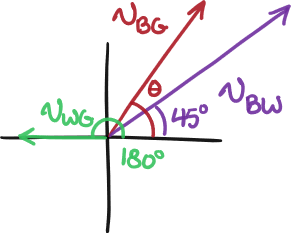Problems titled “Giancoli” are sourced from Physics: Principles with Applications by Giancoli. A problem titled “Giancoli 3-P9,” for example, refers to problem 9 from chapter 3 (P refers to problem, Q refers to question).
Giancoli 3-P9
Three vectors are shown in Fig. 3–35. Their magnitudes are given in arbitrary units. Determine the sum of the three vectors. Give the resultant in terms of (a) components (b) magnitude and angle with the axis.
Solution to 3-P9
The components of the vectors are as follows.
The sum found the vectors can be found by adding the components.
This vector lies in quadrant I. The magnitude and angle of the resultant vector can then be found using the Pythagorean theorem and tangent function, respectively.
Giancoli 3-P16
You are given a vector in the plane that has a magnitude of units and a component of units. (a) What are the two possibilities for its component? (b) Assuming the component is known to be positive, specify the vector which, if you add it to the original one, would give a resultant vector that is units long and points entirely in the direction.
Solution to 3-P16
Let’s call this vector . We are told that and . The fact that restricts to only and From this, we can compute one possible value for , where is the angle between and the -axis, by taking advantage of the function.
This is a angle. The corresponding angle will have the same reference angle and can be found by computing
(Creating a sketch of the two possible angles may be helpful here.) Hence
From this, can be found.
Hence,
For part (b), we are told to choose . We need a new vector such that the sum satisfies . The vector is then able to be found via subtraction.
Giancoli 3-P48
A boat, whose speed in still water is , must cross a -wide river and arrive at a point upstream from where it starts (Fig. 3–45). To do so, the pilot must head the boat at a upstream angle. What is the speed of the river’s current?
Hint for 3-P48
For this problem, let the velocity of the water relative to the ground be the velocity of the boat relative to the water be and the velocity of the boat relative to the ground be The relationship between these three vectors is
Solution to 3-P48
Let’s begin by labeling the velocity vectors identified in the hint. In the paragraph below the image I will describe how I computed the value of .
Note that the vector points directly from the start point to the finish point. The angle between this vector is computable by identifying its opposite and adjacent sides in the right triangle formed by the dotted lines and using the function.
Let’s summarize the information that we have available now. Unknown magnitudes are indicated with "".
Here’s a sketch of these three vectors with a shared origin.
Next, let’s arrange them into a tip-to-tail diagram in accordance with the relationship
Finally, let’s break down the diagonal vectors ( and ) into components and also get rid of the vector arrows for simplicity. I also went ahead and labeled the components themselves in terms of the hypotenuses of their respective right triangles by using the and functions.
Remember, is already known (see above), so there are only two unknowns: and . The question asks us to find . So, we will use the diagram to write a system of two equations and eliminate in order to solve for .
Using the most recent diagram, we can equate the vertical sides and horizontal sides of the big rectangle in order to get our two equations.
Let’s solve for via the vertical equation.
Now, substitute this into the horizontal equation and solve for .
Giancoli 3-P52
Two vectors, and , add to a resultant . Describe and if (a) , (b) , (c) .
Solution to 3-P52
(a) and point in the same direction. This is easily seen through the tip-to-tail diagram below.
Note
This is the most extreme case of the triangle inequality. The triangle inequality in general guarantees that regardless of the details of and . The inequality sign turns into an inequality when the two vectors and point in the same direction.
(b) and are perpendicular to each other. This guarantees that the Pythagorean theorem can be applied to the tip-to-tail diagram representing the sum as shown in the diagram below.
(c) Subtracting from both sides of gives , which hence implies . This therefore means that must have zero length (the magnitude of must be zero).
Problem
You are flying a plane and want to go from City A to City B. City A is located northeast of City B and are apart. Your plane has an engine that can provide thrust for a speed of . There is wind oriented south with a speed of .
(a) in which direction do you need to aim the plane?
(b) how long does it take you to get to city B?
Solution
In this relative velocity problem, the three objects of concern are the plane, the air, and the ground.
- In order to go from City A to City B, one needs to travel southwest since City A is northeast of city B. Since the cities are located on the ground, this indicates to us the direction of the velocity of the plane relative to the ground is southwest.
- We are told that the wind is travelling at in the southern direction, which can be interpreted as the velocity of the air relative to the ground
- We are told that the engines of the plane can provide the plane with a speed of relative to the air.
Let’s summarize the three velocities and the information we know about them. Some information is unknown, which is kept blank in the table.
Velocity of… Symbol Magnitude Direction plane rel. to ground southwest air rel. to ground south plane rel. to air These velocities will add as follows.
The information in the table can be arranged in a tip-to-tail vector addition diagram as shown below.
Use the law of sines to compute the angle and thus .
Hence, the direction of is approximately which is the direction that the plane needs to be aimed.
The magnitude of can then be found through the law of sines.
Since the two cities are apart, the amount of time required is








